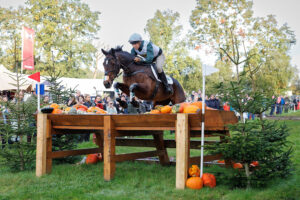Study: Age Predicts Subclinical Laminitis in Horses

Advanced age alone could mean “chronic changes within the hoof capsule have surreptitiously developed without overt signs,” said Nathalie Fouché, DVM, clinician at the Swiss Institute of Equine Medicine (ISME) at the Vetsuisse Faculty of the University of Bern in Switzerland.
In their study, horses over 25 years old were at least three times more likely to have coffin bone rotation visible on radiographs than horses that were 15 to 25 years of age. While further studies including follow-up examinations in larger cohorts of senior horses are needed, Fouché said, these results might indicate that owners of senior horses are more likely to catch early signs of laminitis if they’re getting their horses’ feet X rayed regularly.
“Given the potential severe consequences of progressive laminitis, radiographic examinations might become part of a monitoring program in aged horses in order to implement corrective farriery early in the process and, therefore, increase animal welfare,” Fouché said.
The Study
Fouché and her fellow researchers studied 51 healthy, sound, retired horses aged 15 to 32 and living at the same equine retirement center in Switzerland. They took blood samples to measure adrenocorticotropic hormone levels (ACTH, an indicator of PPID), assigned the horses cresty neck scores, evaluated body condition, and measured coffin bone angles based on radiographs they took of the front feet.
None of the horses showed clinical signs of either acute laminitis or PPID, she said. However, almost half the horses had measurable signs of coffin bone rotation in their radiographs. Horses 25 years and older were more likely to show radiographic signs of chronic laminitis than horses between 15 and 25 years of age.
Horses with higher body condition scores (BCS) or cresty neck scores (CNS) and horses with ACTH concentrations above the seasonally adjusted reference range were not more likely to have chronic laminitis than horses with low BCS and CNS and normal ACTH concentrations, she said.
“Our results show that horses can have chronic laminitis in the absence of clinical signs of PPID and increased ACTH concentrations,” Fouché said. “Thus, we still lack a good laboratory biomarker for the development of subclinical laminitis in aged horses,” adding that insulin might be the answer, but more research is needed in subclinical cases.
The fact that older horses were more likely to have radiographic signs of subclinical laminitis was “not a surprise” to the researchers. “But we would have expected that this was accompanied by the risk factors we had monitored,” she said, adding they were “a bit disappointed” that ACTH didn’t predict chronic laminitis.
The take-home message for owners of senior horses, therefore, is critical: “Knowing that age is an important factor might raise the awareness for laminitis in that age group, even if the horses don’t show clinical signs of either PPID or laminitis,” Fouché said.

Related Articles
Stay on top of the most recent Horse Health news with


















